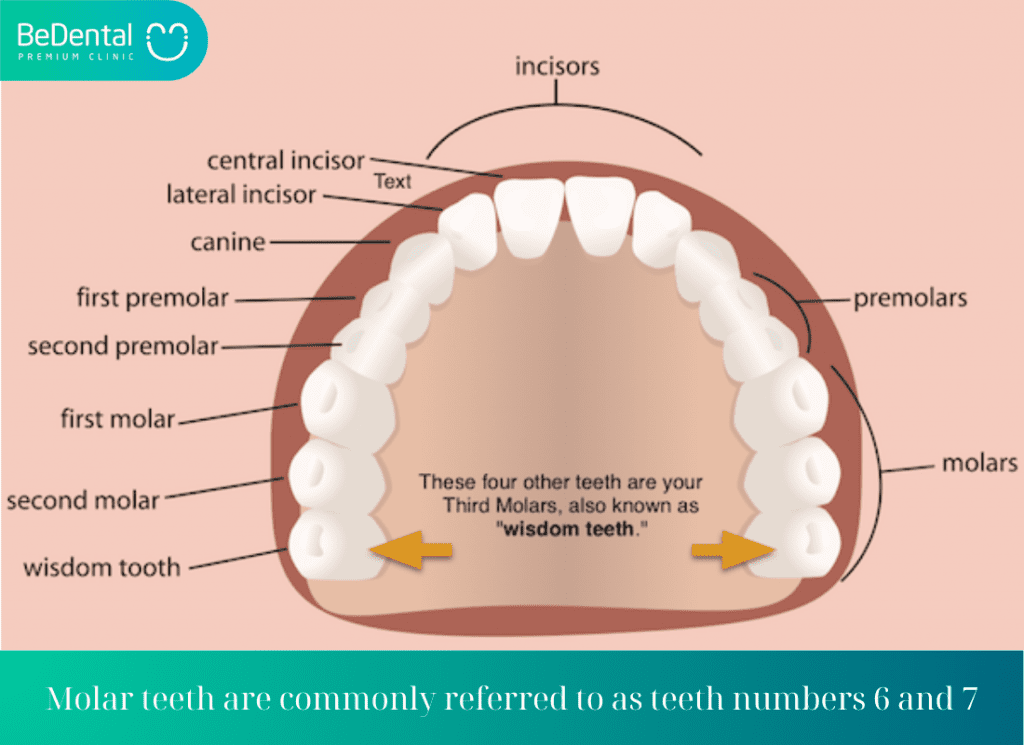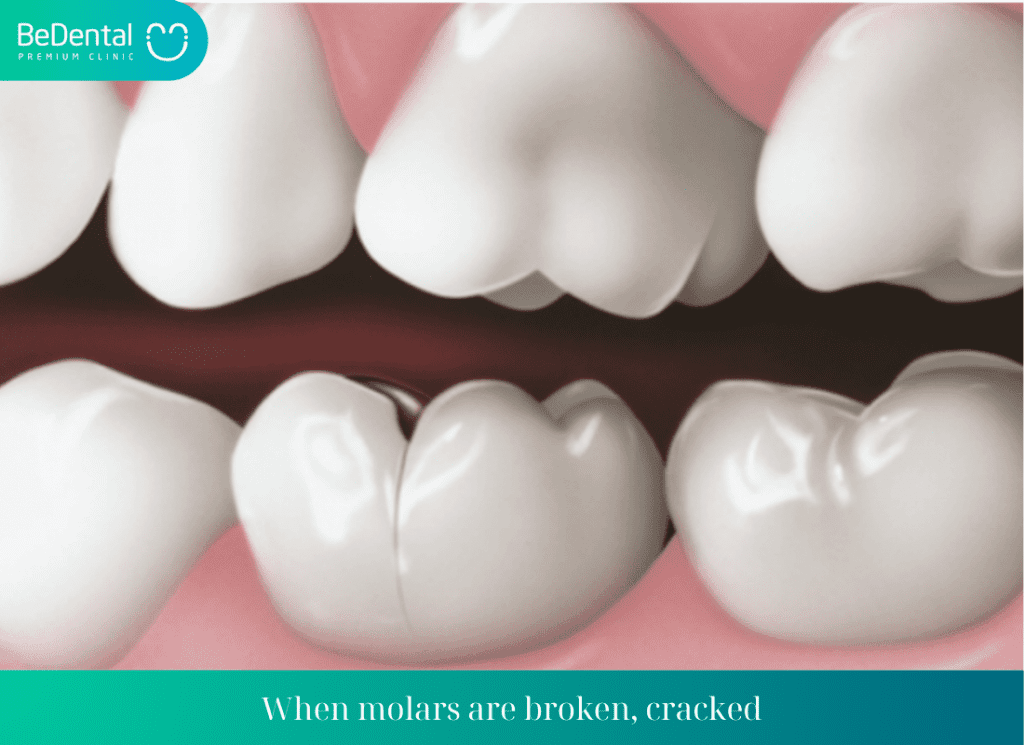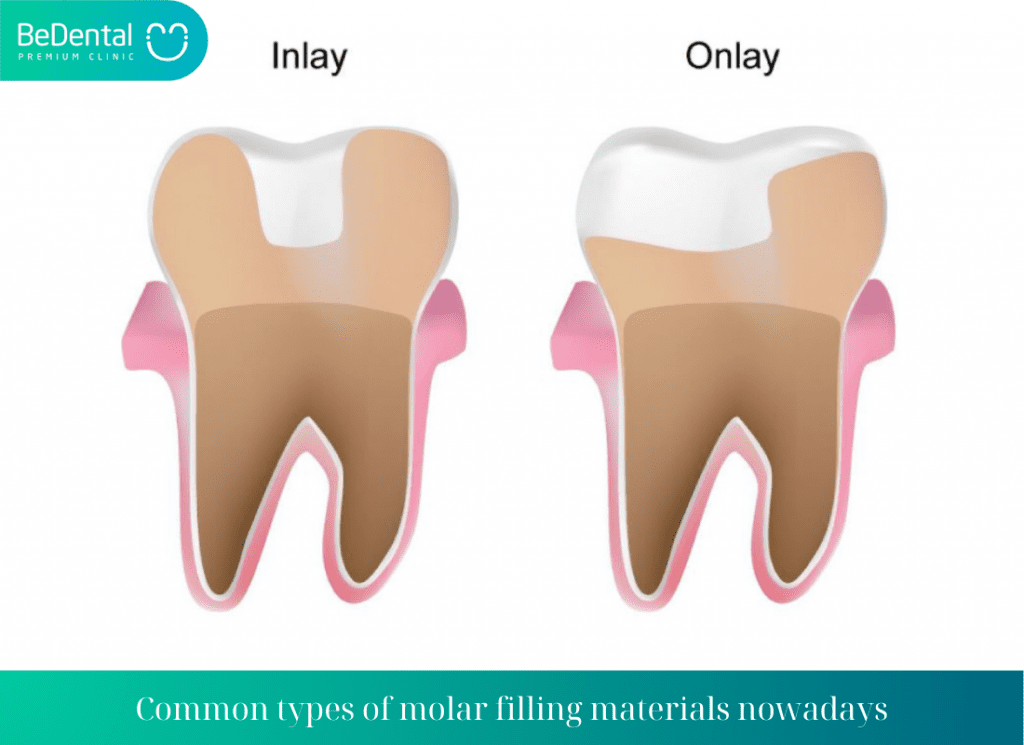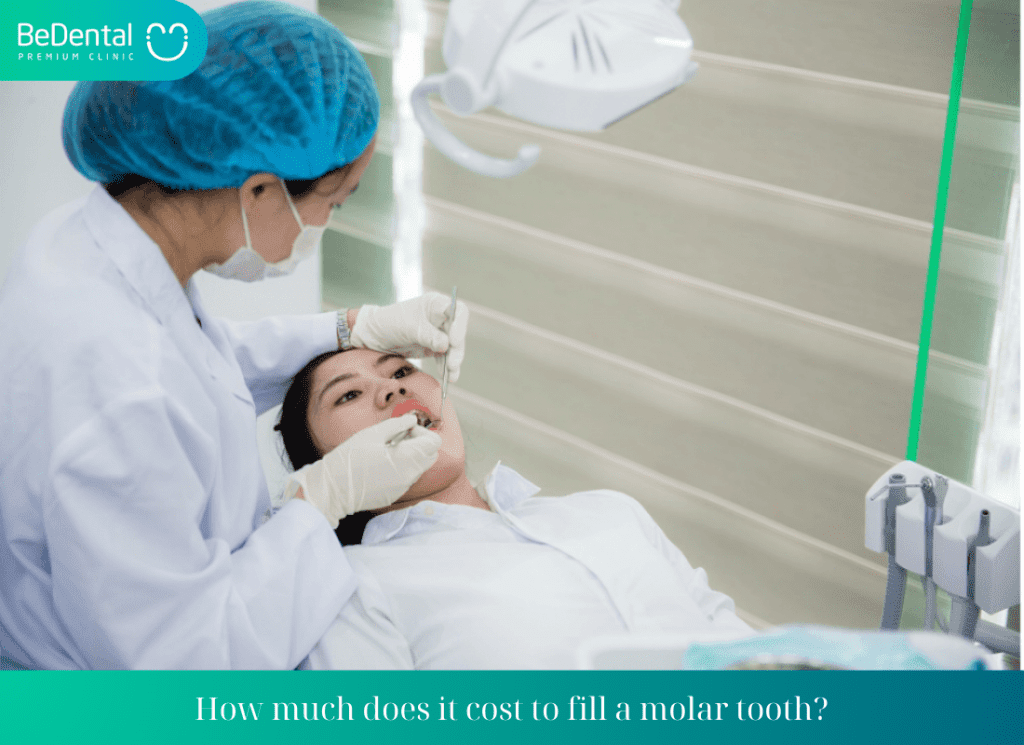How Much Does Dental Filling Cost? The cost of filling a decayed molar tooth can vary significantly depending on various factors such as the condition of the tooth, the type of filling material used, and the specific dental clinic. Below are some reference information on the cost of filling a decayed molar tooth.
What are molar teeth and where are they located?
Molar teeth are commonly referred to as teeth numbers 6 and 7, located at the back of the mouth. In the adult mouth, each jaw (upper and lower) typically has 8 molar teeth.
These molars have large chewing surfaces responsible for grinding food before swallowing. However, due to their hard-to-reach location, molars are prone to cracking or decay if not properly cared for and cleaned.

Cases that require filling molars
What are the Cases that require filling molars? Filling a molar tooth is a method known for its simplicity, cost-effectiveness, and high efficiency in treating damage on tooth number 6.
Due to these advantages, most people prefer filling molar tooth number 6 rather than using other techniques.
See more: How long do fillings last before replacement is needed?
When molars are decayed
If oral hygiene is not carefully maintained, tooth decay will progress and spread, creating larger cavities.
Therefore, at the first signs of slight tooth decay, filling a molar tooth is often a common choice in dental treatment. This method uses filling materials such as silicate cement, composite, or porcelain to seal the cavity on the tooth’s surface.
When molar tooth number 6 is treated for decay and properly filled, bacteria will no longer have the opportunity to attack. In addition to restoring chewing function, the aesthetic appearance of the molar tooth is also perfectly restored.
When molars are broken, cracked

Similarly to cases of tooth decay, when molars are broken due to trauma, they also need to be promptly addressed.
Filling molar tooth number 6 when it is broken or cracked is often straightforward but depends on the extent of the damage on the tooth.
If the molar tooth is broken or has a small crack, molar filling is usually done quickly. The dentist simply needs to clean the tooth, then apply the filling material and shape it to restore the natural tooth.
See more: Does a root canal filling hurt?
In cases where molar tooth number 6 is significantly broken or cracked, filling can still be done, but the durability of the filling may not be high. Therefore, the dentist may recommend the customer to opt for Inlay-Onlay porcelain fillings or ceramic crowns.
Common types of molar filling materials nowadays
What are some of the Common types of molar filling materials? To provide a variety of choices for everyone, dental clinics offer a range of filling materials. However, not everyone understands which material is good and sustainable.
Regarding Composite and Amalgam filling materials
Below are two types of filling materials commonly used for treating molars, each with its own advantages and disadvantages, suitable for specific cases.
Amalgam fillings are typically gray in color, not matching the natural color of the teeth, so they are not highly rated in terms of aesthetics. The amalgam alloy reacts easily to temperature, causing sensitivity when in contact with hot or cold foods.
Although introduced later, composite fillings have many superior advantages, overcoming the limitations of amalgam in terms of aesthetics, safety, strength, thermal conductivity, and other aspects.
Composite fillings have a natural tooth color, while being able to withstand five times the force of real teeth. Therefore, when molars are damaged, choosing composite fillings is a safe and effective method for tooth restoration.
Regarding Inlay/Onlay porcelain fillings
Molar teeth play a crucial role in the chewing process and often endure pressure from eating activities. To ensure chewing function, choosing Inlay Emax or Onlay Emax porcelain fillings is an optimal solution for filling molars.
Inlay/Onlay is made from layers of pure porcelain through CAD/CAM technology, ensuring a natural color that matches real teeth. If you care for the fillings properly, their lifespan can last up to 15-20 years.
Regarding the cost of filling molars with Inlay/Onlay porcelain materials, the current price is relatively high, averaging around 5,000,000 VND per tooth. Before making a decision, you should carefully consider and choose the material that fits your financial situation.

Filling teeth with gold and precious metals
In the past, filling teeth with gold and precious metals was commonly used. This material is extremely hard and durable, surpassing Amalgam. With long-term use, they are difficult to chip. However, due to the metal color, they are not highly rated in terms of aesthetics. Therefore, they are often used to fill molars using the Inlay/Onlay method to improve aesthetics.
How Much Does Dental Filling Cost?
The cost of filling molar tooth number 6 will mainly depend on the type of material used. The costs below can be used as a reference:
| Danh mục | Unit | Giá thành | |
|---|---|---|---|
| 1.Teeth filling (More detail...) | |||
| Baby teeth filling | 1 Unit | 250.000 ~ 10$ |
|
| Permanent Teeth Filling | 1 Unit | 500.000 ~ 20$ |
|
Cosmetic Filling | 1 Unit | 700.000 ~ 28$ |
|
Sensitive teeth filling | 1 Unit | 500.000 ~ 20$ |
|
| Composite bonding | 1 Unit | 1.000.000 ~ 40$ |
|
| 2.Root Canal Treatment - Anterior by endodontist machine (More detail...) | |||
| Root Canal Treatment - Anterior for baby teeth | 1 Unit | 800.000 ~ 31$ |
|
| Root Canal Treatment - Anterior for Front teeth | 1 Unit | 1.200.000 ~ 47$ |
|
| Root Canal Treatment - Anterior for Premolar teeth | 1 Unit | 1.500.000 ~ 59$ |
|
| Root Canal Treatment - Anterior for molar teeth | 1 Unit | 2.000.000 ~ 79$ |
|
| 3.Root Canal reTreatment - Anterior by endodontist machine | |||
| Root Canal Treatment - Anterior for Front teeth by endodontist machine | 1 Unit | 1.500.000 ~ 59$ |
|
| Anterior for Premolar teeth by endodontist machine | 1 Unit | 1.800.000 ~ 71$ |
|
| Anterior for molar teeth by endodontist machine | 1 Unit | 2.300.000 ~ 90$ |
|
| 4 Vecniflour dental care (More detail...) | |||
| Vecniflour dental care for child | 1 Unit | 500.000 ~ 20$ |
Typically, the cost of filling a molar tooth ranges from 200,000 to 700,000 VND, especially with Inlay/Onlay fillings, which can cost up to 5 million VND per tooth.
However, choosing the appropriate material for the condition of the tooth should be based on the advice of experienced professional dentists.
Laser Tech technology is currently favored by many customers with a cost of around 700,000 VND per tooth.

Preventing molars from getting cavities
Molar teeth play a crucial role in the process of chewing and grinding food. Therefore, protecting molars to prevent cavities is extremely important. Below are some effective methods to prevent cavities in molars:
Maintain daily oral hygiene
- Brush your teeth at least twice a day using a soft toothbrush and fluoride toothpaste. Ensure to clean the chewing surfaces of molars thoroughly.
- Combine flossing and brushing to clean between teeth and the gumline around molars, where the toothbrush may not reach easily.
- Use mouthwash containing fluoride or antimicrobial agents to help eliminate bacteria and plaque.

Healthy diet
- Limit the consumption of sweets, especially foods and drinks containing sugar, as sugar is the main cause of tooth decay.
- Include foods rich in calcium and vitamin D to strengthen tooth enamel and prevent cavities.
- Drink enough water daily not only to clean the mouth but also to provide minerals that protect tooth enamel.
Regular dental check-ups
- Visit the dentist for oral examinations at least every 6 months to detect and treat any issues related to molars as well as overall oral health in a timely manner.
- Regularly have your teeth cleaned at least every 6 months to remove plaque and tartar, helping prevent bacteria that cause cavities.
Avoid bad habits
- Avoid smoking and alcohol consumption, as these habits are not only harmful to overall health but also increase the risk of cavities and gum diseases.
- Do not use your teeth to bite on hard objects to prevent tooth fractures, which may create opportunities for bacteria to cause cavities.
By following these measures, you can help protect your molars from cavities and maintain oral health in the long run.
This article has helped answer your question about the cost of filling molars. We wish you a smooth and successful molar filling treatment!
Most asked questions from customers
How often should I brush my teeth and for how long?
Dentists typically recommend brushing your teeth at least twice a day, ideally in the morning and before bed. Each brushing session should last for about two minutes to ensure thorough cleaning of all tooth surfaces, including the molars.
It’s important to use a soft-bristled toothbrush and fluoride toothpaste while brushing gently in circular motions to effectively remove plaque and bacteria from your teeth. Remember to also brush your tongue to eliminate bacteria that can cause bad breath.
See more: Can cavities be braced?
What are the signs and symptoms of cavities in molars?
- Tooth sensitivity to hot, cold, sweet, or acidic foods and drinks.
- Pain or discomfort when biting down or chewing.
- Visible holes or pits in the affected tooth.
- Discoloration or dark spots on the tooth surface.
- Sensitivity to pressure on the tooth.
- Swelling or redness of the gums around the affected tooth.
- Bad breath or a foul taste in the mouth.
- Pus around the affected tooth in severe cases.
Conclusion
In conclusion, maintaining good oral hygiene practices, following a healthy diet, staying hydrated, attending regular dental check-ups, and avoiding harmful habits are essential steps in preventing cavities in molars and maintaining overall oral health.
By incorporating these preventive measures into your daily routine, you can protect your teeth from decay and ensure long-term dental health. Remember, proactive dental care is key to a healthy smile and a confident you.





